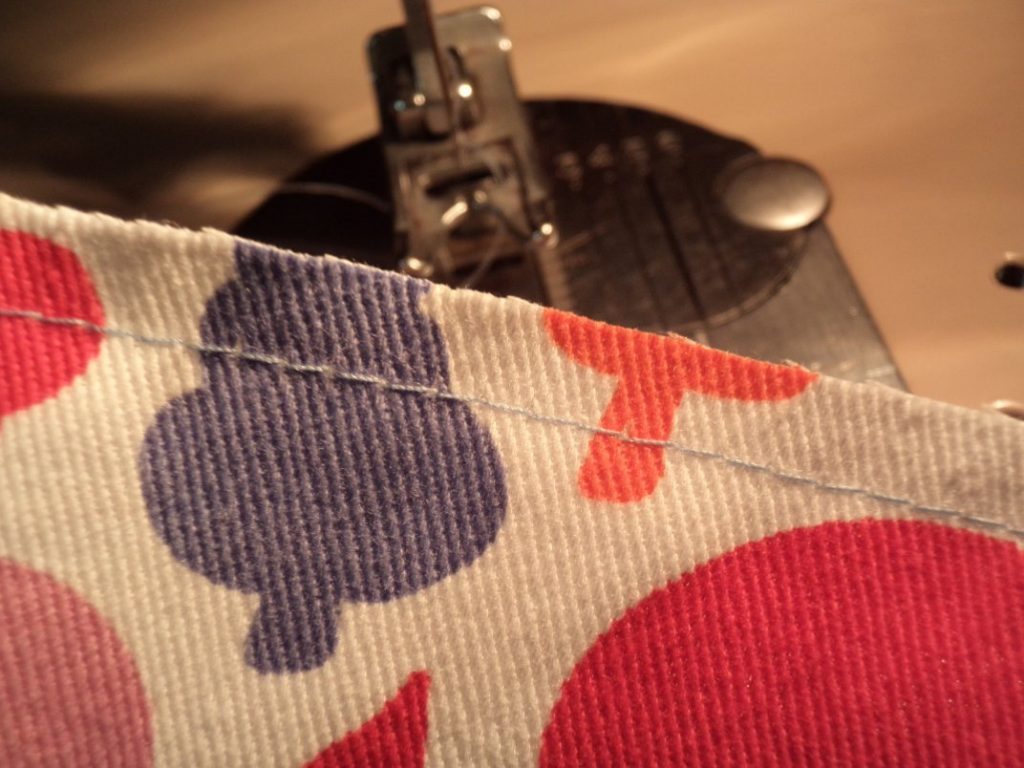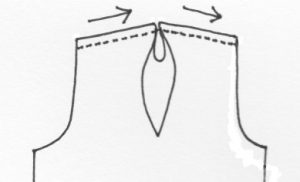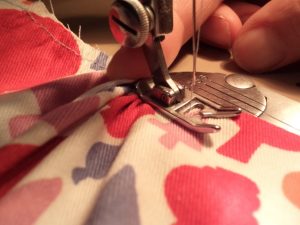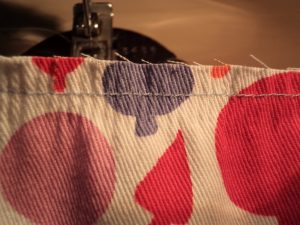Like or Loathe it: stay stitching

This is a true confession: I never do stay stitching.
Just to clarify, if you’re not familiar with the term, stay stitching is a row of machine stitches (long or regular in length) made to the edge of a garment to stop it from stretching during construction. It’s often the first step in sewing a garment. The stay stitching remains in there forever, because it’s covered by the collar/ binding/ waistband/ whatever that will permanently stabilise the edge. Typically stay stitching is used around necklines, waistlines, and sometimes armholes.
Why don’t I do stay stitching? I can save time if I don’t stay stitch, and I have some other anti-stretching techniques.
Here’s what I do instead:
I try to handle the garment as gently as possible while I sew it. I don’t allow unsupported areas to hang and therefore stretch. For example, I wouldn’t put a partly-made garment on a coat hanger if I thought the unfinished edges would stretch. When I press, I don’t let the fabric hang off the ironing board -sometimes I set the board up next to a table to put the excess fabric on.

When I sew shoulder seams, I stitch them across from one immediately to the other. I leave the link between them uncut until I’m ready to sew around the neck, and that way the neckline cannot be stretched.
To do a fitting, I’ll stabilise the edge beforehand. I might pin or sew the collar or waistband on to hold the edge firm, or sew cotton tape to an edge if it needs it. Ok, I might use stay stitching around a neckline (but that’s the exception that makes the rule).
For the occasional times an area has stretched…

I match the stretched edge evenly with the unstretched one, and pin each end, the centre, then the centres of each half, then the centres of each quarter, etc, “walking in” the fullness. I sew it with the stretched edge underneath.

If the edge is too stretched to do the above, I put Plan B into action: Sew a line of stitching along the edge with a finger behind the presser foot. Sew until it’s bunched up then release it and repeat.

This results in a mini concertina effect, which brings the edge in just enough. So I suppose you could argue that I do stay stitch, only just as a fixative not a preventative!
Have fun not stay stitching!
Cheers!
Wouldn’t it be easier to stay stitch first and then you don’t have to worry so much.
Is everyone else wondering the same thing? I suppose this is just my sewing quirk, or maybe it’s that factory training. Thanks, Kay 🙂
Late in commenting. Been doing some research on stay stitching. I had always assumed it was really a temporary stitch to stablise the fabric and that is was not removed due to it being in the seam allowance. I have come across statements that is never to be removed and or clipped in to as it still serves its purpose once the seam is sewn. I struggle to see how that works. Surely once the seam is sewn, it takes over job of stabilising the curve? For the stay stitching to still be effective, doesn’t it mean the seam has failed?
Yes, that sounds correct. The stay-stitching is just a temporary thing until the actual seam is sewn, then it’s left in there, clipped into, forgotten about. The structural element of the seam takes over to stabilise the edge.
I’m with you Nic; those sound like odd statements!
It does seem to be more common to treat is as something permanent, even to the point of having a shorter stitch length. I just can’t get my head around how on a curved neckline, for example, is meant to sit nicely if the seam allowance is 1.5cm, the stay stitching is 1cm and you only clip to the stay stitching?
Interesting I did find in a McCalls sewing book from the 60’s, it mentioned to stitch a scant 1/8 inch outside the seam allowance, not inside. A Women’s Weekly Singer booklet had very specific instructions on stay stitching, long stitch length and either on the stitch line or just scant of it depending on the pattern piece.
Very intriguing that I am as the information is getting newer, the gap between the seam and the stay stitching is getting wider. (there are some exceptions to this, but they seem to be in the minority)
I am big on asking why do we do things and regretting most of my sewing books are in storage right now.
Hmmmm…so interesting…I just went and looked it up in some sewing books:
Modern Needlework (circa 1930s) and Talbot’s Complete Book of Sewing (1943) don’t have it.
Mansfield’s Clothing Construction (1953) puts it inside the seam allowance only 1/16″ from the stitching line. If you use a matching thread you’re allowed to leave it in. They suggest a long stitch with loose tension in case you need to take it out to do an alteration after a fitting, and a tight short stitch length is to be avoided. They tell you to stay-stitch practically every seam, dart and hemline.
The 1960s books are in the shed, but Golden Hands (1972) simply says it’s a line of hand or machine stitching to prevent stretching, no further details.
The Reader’s Digest Complete Guide to Sewing (1977) puts it just inside the seam line and tells you to stay-stitch all the curved and angled edges. If the fabric is loosely woven or a knit they advise stay-stitching every seam line. Matching thread, regular stitch length and “usually 1cm from the cut edge (except plackets; 6mm)”. (So is it just inside the seam allowance or 1cm from the cut edge???)
To quote myself, The Dressmaker’s Companion (2017) says stitch within the seam allowance and use whatever stitch length you like. Leave the stay-stitching in there.
Further thoughts:
In the example you mention, the curved neckline clearly isn’t going to turn through properly or sit flat because the un-clipped stay-stitching it going to hold it too tight. I’d clip to the seam line after sewing the seam. Actually I would trim the seam allowance back to 6mm before (if not after) sewing to get a good curve, then check to see if clipping is necessary. If so, I’d clip to the seam line.
If you stitch outside the seam allowance as per McCalls, not only would you have to unpick the stay-stitching but you’ll probably have to remove the holes in the fabric too.
The ideal stitch length seems to be a thing that varies from person to person – some people like to use a long stitch, some like a regular stitch length and some use a short length. I don’t think the stitch length is a major big deal unless it’s so small and tight it distorts the fabric.
I’d never considered that stay-stitching wouldn’t be clipped if needed.
My own attitude for stay-stitching and much of sewing is “if it works, do it”. It’s sensible to read to discover methods and ask Why We Do Stuff, and in the end, common sense and experience are the things that decide how, when or if we stay-stitch.
Thanks for these intriguing comments Nic!